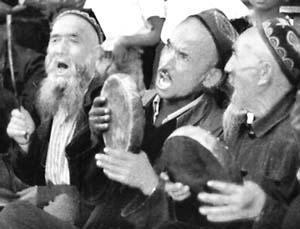Known as the "mother of Uygur music," the "Twelve Muqam" has a long history. Some scholars believe its origin can be traced back to the "Great Western Region Melody" that flourished during the Han (206BC-AD220) and Tang (618-907) dynasties and enjoyed a high popularity in Central China.

In the mid-16th century, aided by other musicians, the imperial concubine Amannisahan of the Yarkant Kingdom, who was also an esteemed poetess and musician, devoted all her efforts to collecting and compiling Muqam music, which was then scattered across Uygur-populated areas. She finally worked out 12 grand, yet light and entertaining compositions that are now known as the "TwelveMuqam."
The music of other ethnic groups is no match for the gigantic and neatly arranged system of the "TwelveMuqam." Strictly following the astronomical almanac, each of the "TwelveMuqam" is divided into three parts: Cong Naghma, Dastan, and Mashrap, each with 25-30 sub-melodies. The whole set of the "TwelveMuqam" consists of 360 different melodies and takes over 20 hours to play in full.
While Muqam is a musical form that has spread in Islamic areas throughout the world, the "TwelveMuqam" carries distinct Uygur characteristics. What is significant about its compilation is that Amannisahan did not borrow material from the wealthy and fully developed Arabian and Persian repertoires. Instead, she exploited the rich resources of Uygur folk music spread out in the wide area in the north and south of the Tianshan Mountains. As a result, the "TwelveMuqam" is especially distinct due to its strong Uygur flavor.
Since its spread among the Uygurs, the "TwelveMuqam" has played an inseparable role in the people's lives. They dance to the accompaniment of "TwelveMuqam" and sing songs and ballads to its melodies.
After the founding of new China (1949), the local government of the Xinjiang Uygur Autonomous Region made every effort possible to preserve the "TwelveMuqam." In 1956,Muqammaster Turdi Ahun and musician Wan Tongshu, working with other assistants, took great pains to record most of the vocal melodies and librettos of the "TwelveMuqam" on tape. They also recorded the music by hand. Their efforts paved the way for the renaissance of this cultural tradition. In 1960, two volumes of "TwelveMuqam" sung by Turdi Ahun were published. The oral cultural heritage was finally secured in the form of its first publication.
Over the past two decades, local Xinjiang cultural institutions have sponsored seminars, supported research projects, and published a number of books with the "TwelveMuqam" as the focal theme. Over the past four years, 7,000 performers -- many of them Uygurs -- have participated in the national key publication project. Their concerted efforts have resulted in the release of CDs, VCDs and DVDs of the "TwelveMuqamof Uygur".
